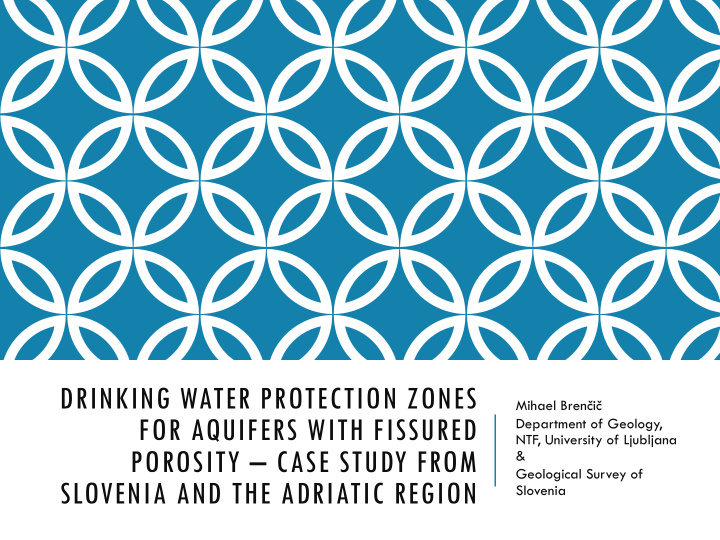



DRINKING WATER PROTECTION ZONES Mihael Bren č i č FOR AQUIFERS WITH FISSURED Department of Geology, NTF, University of Ljubljana POROSITY – CASE STUDY FROM & Geological Survey of SLOVENIA AND THE ADRIATIC REGION Slovenia
CONTENT Introduction Drinking water protection zones in Slovenia Conceptual approach to DWPZ Slovenian DPWZ on non-karstic aquifers DPWZ in Adriatic Ionian region Adriatic Ionian DPWZ on non-karstic aquifers Conclusions
INTRODUCTION Protection of the contributing area of drinking water resource Different practices among states and counties Illustration of some practices in Slovenia and in the Adriatic Ionian region Design and implementation of DWPZ depend on several factors Natural conditions Legal system Tradition
Prestor et al., 2005
DWPZ IN SLOVENIA Safeguard zones for water in thermal spas – before WWII First safeguard zones in the modern sense in mid 50’s of 20 th century (city of Ljubljana) Real start of drinking water protection in 70’s (karst water resources, other bigger cities) Until 2002 drinking water protection was responsibility of local communities New water law in 2002 (implementation of WFD) Drinking water protection is responsibility of the state New rules – “Rules on the criteria for the determination of drinking water protection zones” implemented in 2004; according to recent estimates needing revision
CONCEPTUAL APPROACH TO DWPZ For main protection zones: Abstraction zone (zone of capturing) Inner protection zone Middle protection zone Outer protection zone (recharge area) Sub zones On larger safeguard zones Protection principles are not discerned according to the capture type Spring Well
CONCEPTUAL APPROACH TO DWPZ
DWPZ ON NON-KARSTIC AQUIFERS Intergranular aquifers Fissured aquifers Mainly dolomitic aquifers (very specific situation) Drinking water of very high quality High yield Predominantly boreholes deeper than 100 m Other fissured aquifers are subordinate Local water resources Due to WFD not treated as public water supply systems
DWPZ ON NON-KARSTIC AQUIFERS Dolomites are specific aquifers Karstified Behaving like limestone aquifers Non-karstified Behaving like combination of intergranular and fissured aquifers Karstification depends on several geological factors and there are no general rules to define if certain type of the dolomite formation will be karstified or not. Spatially dependent karstification
DWPZ ON NON-KARSTIC AQUIFERS During the preparation of “Rules” extensive discussion of the role of the dolomites and how to protect their drinking water resources was conducted When dolomite is karstified from the DPWZ design point of view? Criteria – groundwater velocity 10 m/day
DPWZ IN ADRIATIC IONIAN REGION Analysis of DWPZ (Albania, Bosnia and Herzegovina, Croatia, Italy, Greece, Montenegro, Serbia, Slovenia) Nearly all countries have well elaborated principles for karstic aquifers Zoning principles Guidelines are defined according to geological and hydrogelogical conditions in the country Principles for the design of DWPZ Technical principle (bottom up) Natural characteristics principle (top down) Combined principle
DWPZ ON NON-KARSTIC AQUIFERS Countries with guidelines for non-karstic aquifers Intergranular aquifers (porous aquifers) All Fissured aquifer Croatia, Serbia – in combination with karstic aquifers Slovenia – as separate entity similar to main types Bosnia and Herzegovina, Montenegro as karstic aquifers Technical approach based on expert judgement Italy – very diverse situation from county to county Greece
CONCLUSIONS More research is needed On the natural characteristics of the aquifers relevant for their protection from the drinking water resources point of view Management of aquifers and aquifer systems for drinking water supply Common understanding of water resources? Do we need European wide initiative for the common guidelines for the design of drinking water protection zones? Comparative analysis of different practices
Recommend
More recommend